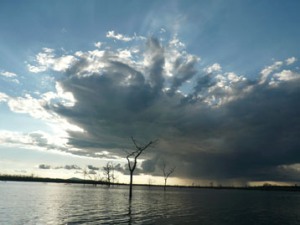Aug 14 2014
For the first time, methane emissions by ebullition from tropical reservoirs have been accurately quantified, revealing that this emission pathway depends on both the water level in the reservoir, which is dependent on the monsoon, and on daily variations in atmospheric pressure.
Although tropical reservoirs probably emit over 10% of anthropogenic methane, their emissions are still poorly quantified. In this study, a new automatic system for the continuous measurement of methane fluxes was deployed on the reservoir of the largest hydroelectric dam in Southeast Asia. The results of this work, which was carried out by researchers at the Laboratoire d'Aérologie (CNRS/Université Toulouse III Paul Sabatier) and the Laboratoire Géosciences Environnement Toulouse (CNRS/Université Toulouse III Paul Sabatier/IRD), are published in the journal Biogeosciences dated 13 August 2014.
 The Nam Theun 2 dam reservoir, Laos. © Copyright: Dominique Serça
The Nam Theun 2 dam reservoir, Laos. © Copyright: Dominique Serça
For the past ten years, it has been known that hydroelectric reservoirs in tropical regions are an important source of methane (CH4), a greenhouse gas that is considerably more powerful than carbon dioxide(1). Methane is produced by bacteria that decompose organic matter in the soils and vegetation flooded when the reservoir is filled. In tropical regions, these reservoirs probably release between 1% and 18% of anthropogenic methane into the atmosphere(2).
However, these emissions are still poorly quantified since only a small number of reservoirs have been studied, and not all the emission pathways have been taken into account. Methane can be released from a reservoir into the atmosphere by diffusion (when the gas dissolved in the water enters the atmosphere), by ebullition (when large gas bubbles rise up from the bottom and burst at the water surface), and, downstream from the turbines, by degassing (turbulence speeds up transfer of dissolved methane to the atmosphere). However, until now, only diffusion had been systematically studied, unlike other pathways.
A team of researchers has been studying the Nam Theun 2 Reservoir in Laos (the largest in Southeast Asia) prior to its filling, in May 2008, to this day. In addition to conventional methods (floating chambers to capture diffusive fluxes of gas, and submerged funnels to trap bubbles), they used an innovative technique to measure total methane emissions. Specifically, a micrometeorological station deployed on the 450 km2 reservoir continuously measured vertical wind speed and CH4 concentrations, which made it possible to calculate the methane flux(3) from the reservoir. Unlike conventional methods, which require human presence, these stations are fully automatic and take measurements every 30 minutes, 24 hours a day.
The measurements carried out on the Nam Theun 2 reservoir enabled the scientists to show that ebullition accounted for 60% to 80% of total emissions from the reservoir in the first years following filling.
In addition, ebullition intensity varies both diurnally and seasonally. During the four months of the hot dry season (mid-February to mid-June), emissions reach their maximum, since water levels are low. Daily variations are controlled by atmospheric pressure: during the two daily pressure drops (in the middle of the day and the middle of the night), CH4 ebullition increases. With the help of a statistical model, day-to-day data related to atmospheric pressure and water level was thus used to reconstruct emissions by ebullition over a continuous four-year period (2009-2013).
The results obtained highlight the importance of very frequent measurements of methane fluxes. They also show that the ebullition process, and therefore the amount of methane emitted from tropical reservoirs during their first years of operation, has most certainly been underestimated until now. For the researchers, the next stage will be to quantify diffusion at the surface of the reservoir and emissions downstream from the dam to the same level of accuracy, so as to complete the assessment of methane emissions from this reservoir, and better assess their contribution to the global greenhouse effect.
(1) Global warming potential is used to estimate the contribution of a gas to global warming (according to its ability to capture infrared radiation emitted by the Earth and its lifespan in the atmosphere). Over a 100-year period, its value is 28 for methane, as compared to 1 for carbon dioxide.
(2) Remaining anthropogenic methane emissions come from agriculture (livestock farming and rice growing), exploitation of hydrocarbons, waste and wastewater.
(3) Methane flux designates the amount of CH4 emitted per m2 per day.